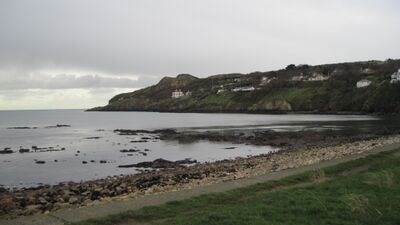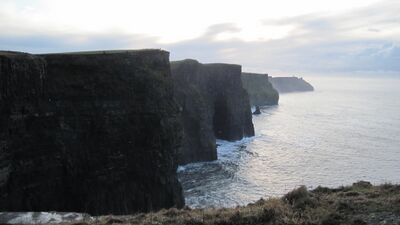Wikimecum:Daytrips to Howth and the Cliffs of Moher
| This page needs one or more photos to improve its quality. Please edit the article to insert one now. |
| This page needs one or more maps to improve its quality. Please edit the article to insert one now. |
People often picture Ireland as a quaint little country composed of small villages and vast open farmland. Many tourists expect flocks of sheep, rolling hills and thatched roofs to blanket the country. However, this is not the case. In recent years, Ireland has progressed from an agricultural country deep in civil war to a modern, technologically oriented, peaceful society. The cities of Dublin, Cork and Galway are on par with Boston, Paris and London. Irish cities are true metropolises; void of the quintessential green pastures that have caught the eye of many tourists. But true to its roots, the countryside is never too far away.
Traveling to Howth
During the Thanksgiving break, I traveled to Ireland (Travel to Ireland from Venice) with eight other students. After exhausting ourselves in the city, we all decided that we wanted to see the Ireland we had all heard about: sheep, small villages and tiny pubs. We asked out hostel receptionist for the closest place that would give us all of this, and he recommended that we travel to a town called Howth a few kilometers north of Dublin.
We departed from Connelly Station, Dublin’s main train station, directly to Howth. A round trip student ticked cost less than 10 euro. The train ride was only about 20 minutes, winding its way through the northern outskirts of Dublin. To our liking, the surroundings slowly began to appear more rural. Before arriving at the station in Howth, you can just see the Irish Sea and Howth Harbor.
Howth is located on the northern side of Howth Head, a peninsula that juts out into the Irish Sea just north of Dublin. It splits the peninsula with Sutton, the town located on the south of the head. Howth Harbor was once a major fishing port, but has since given way to large commercial fishing locations. It now serves as a suburb of Dublin. Yet even with its modernization, Howth still maintains the feel of a rural Irish town miles away from the masses.

Located just beyond the Howth Harbor is a small, unoccupied island known as Ireland’s Eye. Its name is a derivative of “Erin’s Ey.” a combination of ancient Celtic and Norse words. The island is home to only two structures. One is a small military fortification built during the Napoleonic Wars, and the other is the ruin of the Church of the Three Sons of Nessan. The parish was built in the 700s, and served as the church for the town of Howth until one was built on the mainland in the last few hundred years.
Howth is also well known for its hiking trails. There are several trails that travel all over the eastern side of Howth Head, many of which weave through 570 acres of conservation land. The trail that we took on our trip to Howth brought us along the very edge of the peninsula. The landscape was breathtaking, ranging from sheer cliffs to wide, grassy meadows. The trail ended with a view of Dublin and its bay from a highpoint on Howth Head. There are several other trails that vary in difficulty. One climbs to Ben of Howth, a 163-meter rock formation that overlooks the harbod. Another leads to the Bog of the Frogs, a wet and marshy peat bog.
Although the town is small, good, inexpensive food is not hard to come by. Harbour Rd has several pubs that all serve traditional Irish food. There is also a Beshoff’s fish and chips take-away restaurant on Harbour Road. Their prices are moderate, however the portions are far larger than anything you would encounter in Venice. Six euro will buy you an entire cod fillet and a large order of chips, which is definitely enough to fill you up until you return to Dublin.
Western Ireland
For a journey a bit more out of the way, there is always a trip to western Ireland. Galway is a port city on the west coast of Ireland, directly opposite Dublin. Although it is the fourth largest city in the country, the trip to Galway and its rural, picturesque surroundings make it a perfect location for those wishing to take in the Irish countryside. Tickets for an Eirann bus from Dublin to Galway were 18 euro round trip, and the ride was three and a half hours each way. Galway serves as a starting point for exploration of western Ireland, close to the Burren Landscape, Athenry Castle and the Cliffs of Moher.
The Cliffs of Moher
Our group chose to explore the legendary Cliffs of Moher, located on the Atlantic coast of County Clare. The cliffs are located about 80km southeast of Galway. Though it may seem far, there are countless modes of transportation that will bring you there. There is one public bus that leaves Galway station at 10:10 am, in addition to myriad group tour busses. Our group opted to book a taxi service through the local tourist office. Seven of us paid 25 euro each for round trip and admission to the cliffs. We split up into two taxicabs, and were taken to Moher by two friendly, informative drivers.
The drive took us about an hour and a half, and drove through the heart of The Burren, 250 square kilometers of loose-rock mountains. It is home to evidence of early human civilization, including almost 100 megalithic burial sites. Our drive also took us through the green, rolling hills near Athenry, the same landscape immortalized in the Irish Ballad.
The first thing that caught our eye when we got to Moher was not the cliffs, but was infact a thick, low-lying blanket of clouds carpeting the ocean. It was as if someone laid cotton over the sea.

Yet despite these clouds, the sun was shining upon the cliffs, making for a unique and pleasant experience.
The Cliffs of Moher are not simply cliffs; they are a full blown tourist attraction. Built into a hillside is a tourist center, containing a cafeteria, gift shop, and educational experience teaching about the cliffs. Beyond that are the Cliffs of Moher. They were named after a fort, Mothar, that was demolished to make room for a watchtower during the Napoleonic Wars. These cliffs form eight kilometers of the Atlantic Coastline and stand from 120 m to 214m tall. They act as a natural haven for almost 30,000 individual birds from 29 species.
The Cliffs of Moher are impossible to describe through words. Pictures can only begin to convey the vastness of the landscape and the awesomeness of the height. The only way to fully take in these natural masterpieces is to see it with your own eyes.